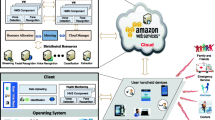Abstract
Smart, interactive healthcare is necessary in the modern age. Several issues, such as accurate diagnosis, low-cost modeling, low-complexity design, seamless transmission, and sufficient storage, should be addressed while developing a complete healthcare framework. In this paper, we propose a patient state recognition system for the healthcare framework. We design the system in such a way that it provides good recognition accuracy, provides low-cost modeling, and is scalable. The system takes two main types of input, video and audio, which are captured in a multi-sensory environment. Speech and video input are processed separately during feature extraction and modeling; these two input modalities are merged at score level, where the scores are obtained from the models of different patients’ states. For the experiments, 100 people were recruited to mimic a patient’s states of normal, pain, and tensed. The experimental results show that the proposed system can achieve an average 98.2 % recognition accuracy.









Similar content being viewed by others
References
Park, C., et al., M2M-based smart health service for human UI/UX using motion recognition. Cluster Comput. 18:221–232, 2015.
Chen, M., Ma, Y., Song, J., Lai, C., Hu, B., Smart clothing: connecting human with clouds and big data for sustainable health monitoring. ACM/Springer Mobile Netw. Appl., 2016. doi:10.1007/s11036-016-0745-1.
Solanas, et al., Smart health: A context aware health paradigm within smart cities. IEEE Commun. Mag. 52(8):74–81, 2014.
Grunerbl, A., et al., Smartphone based recognition of States and state changes in bipolar disorder patients. IEEE J. Biomed. Health Inform. 19(1):140–148, 2015.
Hossain, M. S.: Patient status monitoring for smart home health-care. In: IEEE ICME 2016, Seattle (2016)
Muhammad, G., Automatic speech recognition using interlaced derivative pattern for cloud based healthcare system. Clust. Comput. 18(2):795–802, 2015.
Ma, Y., et al., Robot and cloud-assisted multi-modal healthcare system. Clust. Comput. 18(3):1295–1306, 2015.
Hassanalieragh, M., et al.: Health monitoring and management using internet-of-things (IoT) sensing with cloud-based processing: opportunities and challenges. In: IEEE International Conference on Services Computing, pp. 285–292 (2015)
Jara, J., Zamora-Izquierdo, M. A., Skarmeta, A. F., Interconnection framework for mHealth and remote monitoring based on the internet of things. IEEE J. Sel. Areas Commun. 31(9):47–65, 2013.
Hossain, M. S., and Muhammad, G., Cloud-assisted industrial internet of things (IIoT)-enabled framework for health monitoring. Comput. Netw. 101(2016):192–202, 2016.
Henze, M., Hermerschmidt, L., Kerpen, D., Häußling, R., Rumpe, B., Wehrle, K., A comprehensive approach to privacy in the cloud-based internet of things. Futur. Gener. Comput. Syst. 56(2016):701–718, 2016.
Hossain, M. S., Cloud-supported cyber–physical localization framework for patients monitoring. IEEE Syst. J., 1–10, 2015. doi:10.1109/JSYST.2015.2470644.
Rabiner, L., and Juang, B. H., Fundamentals of Speech Recognition. Englewood Cliffs: Prentice-Hall, 1993.
Campbell, J. P., Speaker recognition: a tutorial. Proc. IEEE 85(9):1437–1462, 1997.
Muhammad, G., et al.: Environment recognition using selected MPEG-7 audio features and mel-frequency cepstral coefficients. In: International Conference on Digital Telecommunications (ICDT10), pp. 11–16, Greece (2010)
Godino-Llorente, J. I., Gomes-Vilda, P., Blanco-Velasco, M., Dimensionality reduction of a pathological voice quality assessment system based on Gaussian mixture models and short-term cepstral parameters. IEEE Trans. Biomed. Eng. 53(10):1943–1953, 2006.
Muhammad, G., et al., Multi directional regression (MDR) based features for automatic voice disorder detection. J. Voice. 26(6):817.e19–817.e27, 2012.
Muhammad, G., et al., Spectro-temporal directional derivative based automatic speech recognition for a serious game scenario. Multimedia Tools Appl. 74(14):5313–5327, 2015.
Viola, P., and Jones, M. J., Robust real-time face detection. Int. J. Comput. Vis. 57(2):137–154, 2004.
Ahonen, T., Hadid, A., Pietikäinen, M., Face description with local binary patterns: application to face recognition. IEEE Trans. Pattern Anal. Mach. Intell. 28(12):2037–2041, 2006.
Chen, J., et al., WLD: A robust local image descriptor. IEEE Trans. Pattern Anal. Mach. Intell. 32(9): 1705–1720, 2010.
Tan, X., and Triggs, B., Enhanced local texture feature sets for face recognition under difficult lighting conditions. IEEE Trans. Image Process. 19(6):1635–1650, 2010.
Shi, X., et al., Towards interactive medical content delivery between simulated body sensor networks and practical data center. J. Med. Syst. 40:214, 2016.
Bishop, C., Pattern Recognition and Machine Learning. New York: Springer, 2006. ISBN 978-0-387-31073-2.
González-Valenzuela, S., Chen, M., Leung, V. C. M., Mobility support for health monitoring at home using wearable sensors. IEEE Trans. Inf. Technol. Biomed. 15(4):539–549, 2011.
Chen, M., Ma, Y., Wang, J., Dung, O. M., Song, E., Enabling comfortable sports therapy for patient: a novel lightweight durable and portable ECG monitoring system. Healthcom, 271–273, 2013.
Li, Y., Dai, W., Ming, Z., Qiu, M., Privacy protection for preventing data over collection in smart city. IEEE Trans. Comput. 610 65(5):1339–1350, 2016.
Acknowledgments
The authors extend their appreciation to the Deanship of Scientific Research at King Saud University, Riyadh, Saudi Arabia for funding this work through the research group project no. RGP-228.
Author information
Authors and Affiliations
Corresponding author
Additional information
This article is part of the Topical Collection on Mobile & Wireless Health
Rights and permissions
About this article
Cite this article
Hossain, M.S. Patient State Recognition System for Healthcare Using Speech and Facial Expressions. J Med Syst 40, 272 (2016). https://doi.org/10.1007/s10916-016-0627-x
Received:
Accepted:
Published:
DOI: https://doi.org/10.1007/s10916-016-0627-x




